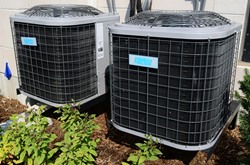How to Enroll In the Right Heating and Cooling Training Program near Stanford California
 Once you have decided on a career as a heating and cooling technician, the next action is to find an HVAC trade school near Stanford CA. But with so many to choose from, how do you decide on the best one to get the training that you require? A number of prospective students will make their choice based exclusively on the price of tuition or how near the school is to their home. Although these are significant factors to consider, they are not the only ones to investigate. A few of the other factors that you need to research are the graduation rates of the HVAC schools, their reputations, and if they are accredited by professional trade organizations. Those and additional benchmarks will be covered in more detail later in this article. But before we examine how to select an HVAC trade school, let’s look at what a heating and cooling professional does to become a licensed skilled tradesman.
Once you have decided on a career as a heating and cooling technician, the next action is to find an HVAC trade school near Stanford CA. But with so many to choose from, how do you decide on the best one to get the training that you require? A number of prospective students will make their choice based exclusively on the price of tuition or how near the school is to their home. Although these are significant factors to consider, they are not the only ones to investigate. A few of the other factors that you need to research are the graduation rates of the HVAC schools, their reputations, and if they are accredited by professional trade organizations. Those and additional benchmarks will be covered in more detail later in this article. But before we examine how to select an HVAC trade school, let’s look at what a heating and cooling professional does to become a licensed skilled tradesman.
Becoming an HVAC Technician
 HVAC is an acronym that is widely used in the business that stands for “Heating, Ventilation and Air Conditioning”. HVAC contractors specialize in the installation, repair and maintenance of central air conditioners, furnaces, boilers, water heaters and heating systems. As professional tradesmen, they are commonly required to be licensed, however each state and local municipality has its own criteria. Attaining professional certification is not required, but a voluntary means for Stanford CA HVAC technicians to establish that they are exceptionally qualified and experienced in their area of expertise. There are multiple recognized certifications within the field that are available. Here are a few of the significant ones.
HVAC is an acronym that is widely used in the business that stands for “Heating, Ventilation and Air Conditioning”. HVAC contractors specialize in the installation, repair and maintenance of central air conditioners, furnaces, boilers, water heaters and heating systems. As professional tradesmen, they are commonly required to be licensed, however each state and local municipality has its own criteria. Attaining professional certification is not required, but a voluntary means for Stanford CA HVAC technicians to establish that they are exceptionally qualified and experienced in their area of expertise. There are multiple recognized certifications within the field that are available. Here are a few of the significant ones.
- North American Technician Excellence (NATE). NATE is a nationally acknowledged certification for HVAC techs. The certification is attained by passing a competency examination and may be received in one or more specialties.
- HVAC Excellence. This certification offers both a professional and a master specialist credential. 2 years of professional experience as well as passing a comprehensive examination are required for the professional level certification. Master specialists need to have 3 years of experience in addition to a passing score on the professional level exam. Similar to NATE, certifications are made available in various specialties.
- EPA Section 608. This certification is necessary for techs that work with refrigerants. There are three forms of certification offered, one for small appliances, and the additional two for low and high pressure refrigerants.
Because licensing could be required in your location, and you may also desire to earn certification, it’s imperative that you pick an HVAC technical school that will prepare you for both. And since you will probably be handling refrigerants, make certain that the school you pick preps you for passing the EPA Section 608 exams.
HVAC Degree and Certificate Classes
 There are a number of options offered for HVAC training in a technical or vocational school. You can attain a certificate, an Associate Degree, or a Bachelor’s Degree. Acquiring a certificate will take the minimum amount of time, typically completed in as little as six months, although some courses are longer. A certificate will qualify you for the majority of HVAC positions, particularly if you are licensed and have certification applicable to the position. The degree training programs may provide a competitive edge for securing employment and will provide more in-depth training than the certificate programs. Below is a brief explanation of each credential offered near Stanford CA.
There are a number of options offered for HVAC training in a technical or vocational school. You can attain a certificate, an Associate Degree, or a Bachelor’s Degree. Acquiring a certificate will take the minimum amount of time, typically completed in as little as six months, although some courses are longer. A certificate will qualify you for the majority of HVAC positions, particularly if you are licensed and have certification applicable to the position. The degree training programs may provide a competitive edge for securing employment and will provide more in-depth training than the certificate programs. Below is a brief explanation of each credential offered near Stanford CA.
- Certificate. Generally requiring a high school diploma, certificate programs are preferred among beginning residential or commercial HVAC specialists. They provide a strong foundation of skills for job opportunities within the industry.
- Associate Degree. The Associate Degree in HVAC program provides a more exhaustive background of heating & cooling systems than the certificate program. Typically requiring two years to finish, many degrees include an internship or work-study program.
- Bachelor’s Degree. The Bachelor’s Degree in HVAC is tailored more for a career in management or even business ownership. Some programs require an Associate Degree, while others are a standard 4 year program. In addition to mastering how to service and maintain heating and air conditioning systems, you will also study how to design them.
Selecting the appropriate credential program will be dependent on what your future career goals are, as well as the time and financial resources that you have to commit. One option is to start with a certificate or even an Associate Degree program, and after acquiring some experience in the trade in Stanford CA, eventually going back to obtain a Bachelor’s Degree. If this is your approach, make sure to ask the HVAC tech school you are considering about how their returning student program works.
HVAC Online Training
 Choosing an HVAC school online is one alternative to getting your education and earning a certificate or degree. Almost all schools will require some attendance on campus to participate in hands on training. Some also sponsor internship or work-study programs in addition to or in place of practical lab work. But since the balance of the classes may be participated in via the internet, this alternative may be a more convenient solution for many Stanford CA students that are pressed for time. And some online degree programs are less costly than other on campus alternatives. Even commuting expenses from Stanford and study supplies may be minimized, helping to make education more affordable. And numerous online programs are fully accredited (more on this later). So if your job or family responsibilities have left you with limited time to attend classes, maybe an HVAC online training program will make it less complicated to accommodate school into your busy lifestyle.
Choosing an HVAC school online is one alternative to getting your education and earning a certificate or degree. Almost all schools will require some attendance on campus to participate in hands on training. Some also sponsor internship or work-study programs in addition to or in place of practical lab work. But since the balance of the classes may be participated in via the internet, this alternative may be a more convenient solution for many Stanford CA students that are pressed for time. And some online degree programs are less costly than other on campus alternatives. Even commuting expenses from Stanford and study supplies may be minimized, helping to make education more affordable. And numerous online programs are fully accredited (more on this later). So if your job or family responsibilities have left you with limited time to attend classes, maybe an HVAC online training program will make it less complicated to accommodate school into your busy lifestyle.
What to Ask HVAC Certification Classes
 As soon as you have picked the type of certificate or degree that you desire to obtain, either on campus or online, you can begin to decrease your list of schools. As you are certainly aware, there are numerous HVAC vocational schools in the Stanford CA area and across the USA to select from. That’s why it is essential to have a checklist of important qualifications when making school assessments. As formerly stated in our opening paragraph, tuition and location will probably be the first two aspects you will consider. Following are several additional ones that you need to explore before enrolling in your school of choice.
As soon as you have picked the type of certificate or degree that you desire to obtain, either on campus or online, you can begin to decrease your list of schools. As you are certainly aware, there are numerous HVAC vocational schools in the Stanford CA area and across the USA to select from. That’s why it is essential to have a checklist of important qualifications when making school assessments. As formerly stated in our opening paragraph, tuition and location will probably be the first two aspects you will consider. Following are several additional ones that you need to explore before enrolling in your school of choice.
Accreditation. A large number of HVAC vocational programs in the Stanford CA area have attained either a regional or a national accreditation. They may acquire Institutional Accreditation, which focuses on the school’s programs as a whole, or Programmatic Accreditation, which pertains to a specific program, such as HVAC technology. Verify that the program is accredited by a U.S. Department of Education acknowledged accrediting organization, for instance the Accreditation Board for Engineering and Technology. Along with helping ensure that you acquire an excellent education, it can assist in acquiring financial assistance or student loans, which are often not available for non-accredited programs. Also, some states mandate that the HVAC training program be accredited in order to be approved for licensing.
High Completion Rates. Ask the Heating and Air Conditioning schools you are looking at what their completion rates are. The completion rate is the percentage or portion of students who enroll in and finish the program. A lower completion rate could suggest that students were unhappy with the course and quit. It may also mean that the instructors were not competent to instruct the students. It’s similarly essential that the schools have high job placement rates. Older and/or more reputable schools may have a more extensive directory of graduates, which can mean more contacts for the school to employ for their apprenticeship and job placement programs. A high job placement rate will not only affirm that the school has an excellent reputation within the field, but also that it has the network of Stanford CA HVAC employers to assist students acquire apprenticeships or jobs.
Apprenticeship Programs. Most HVAC technical programs are taught together with an apprenticeship or an internship program. Those participating technical and vocational programs will help place you in an apprenticeship program within their network of HVAC businesses or labor unions. Find out if the schools you are comparing have referring relationships with local Stanford CA HVAC specialists. An apprenticeship not only offers a valuable experience by supplying hands-on training, but it also supplies job opportunities and helps to form relationships in the local HVAC professional community.
Modern Facilities. Confirm that the campus facilities and the equipment that you will be instructed on are up-to-date and what you will be using in the field. If you are presently in an internship or an apprenticeship, consult with the HVAC tech you are working under concerning what you should be expecting. If not, ask a local Stanford CA HVAC contracting company if they can give you some suggestions. Also keep in mind that unless you can relocate, the school must be within commuting distance of your Stanford CA home. Remember that if you decide to enroll in an out-of-state school, besides the added moving costs there can be increased tuition fees compared to in-state residents.
Smaller Classes. It’s important that you get as much individualized training as possible, which can be difficult in larger classes. Ask if you can monitor a couple of the classes so that you can observe how big they are and witness first hand the interaction between teachers and students. Speak to several of the students and get their feedback regarding class sizes and instruction. Finally, speak with some of the instructors and find out what their level of expertise is and what certifications or degrees they hold.
Flexible Scheduling. Make sure that the class schedules for the schools you are assessing are flexible enough to handle your needs. If you can only attend classes in the evening or on weekends near Stanford CA, check that the schools you are comparing offer those options. If you can only attend part-time, make sure that the school you select offers part-time enrollment. Finally, check out what the protocol is to make-up classes should you miss any because of work, illness or family emergencies.
Considering an HVAC School near Stanford CA?
Perhaps you are considering enrolling in an HVAC training program in the Stanford California area. If so, you may find the following background information about the location of your new school campus both interesting and informative.
Stanford, California
Stanford is a census-designated place (CDP) in Santa Clara County, California, United States and is the home of Stanford University. The population was 13,809 at the 2010 census, with a daily population of 35,000.[3]
Most of the Stanford University campus and other core University owned land is situated within the census-designated place of Stanford though the Stanford University Medical Center, the Stanford Shopping Center, and the Stanford Research Park are officially part of the city of Palo Alto. Its resident population consists of the inhabitants of on-campus housing, including graduate student residences and single-family homes and condominiums owned by their faculty inhabitants but located on leased Stanford land. A residential neighborhood adjacent to the Stanford campus, College Terrace, featuring streets named after universities and colleges, including Cambridge, Oxford, Harvard and Princeton, is neither part of the Stanford CDP nor owned by the University but is part of Palo Alto.
According to the United States Census Bureau, the CDP has a total area of 2.8 square miles (7.3 km2), of which, 2.7 square miles (7.0 km2) of it is land and 0.045 square miles (0.12 km2) of it (1.64%) is water.
Top HVAC Schools Stanford CA
Selecting the right HVAC training course is a crucial beginning toward a fulfilling career in the heating & cooling field. You originally came to this website because you wanted more information regarding Top HVAC Schools. However, as we have covered in this article, you should select an Heating and Cooling vocational school and a certificate or degree program that are both accredited and have outstanding reputations within the HVAC community. Other features to search for are ample practical training and state-of-the-art facilities. You need to check out each of the schools personally that you are most interested in to inspect the campus and talk with both the current students and faculty. Attempt to get a feel for the quality of the instruction and the interaction between them. In addition, ask about scheduling options and whether evening or weekend classes are offered if needed. And remember to inquire about financial aid and student loan options as well. If you ask the appropriate questions as we have laid out in our checklist for evaluating schools, you’ll be able to narrow down your options so that you can make an educated decision. With the proper training, hard work and dedication, you can ultimately become a licensed HVAC professional in Stanford CA.
More Hot and Cool Locations in California
Business Results 1 - 10 of 1500












